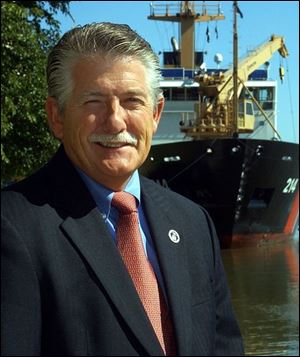
More shipping is the goal
10/1/2004
U.S. Maritime Administrator William Schubert, a former ship captain, had a tour of the Port of Toledo yesterday.
U.S. Maritime Administrator William Schubert said yesterday in Toledo that Great Lakes shipping was busier this year compared to last, and that he is working on ways to boost "short-sea" shipping in the Midwest.
The concept is a throwback to when lakes and connecting rivers were used to ship most goods in middle America, before interstate highways.
The official push in Washington by the President Bush appointee, whose office is in the U.S. Department of Transportation, coincides with a long-term goal of Jim Hartung, president of the Toledo-Lucas County Port Authority, to win shipping business that might otherwise go to rails and roadways.
Mr. Hartung is negotiating with hog farmers in North Carolina and the federal government to transport corn feed by way of the Port of Toledo and St. Lawrence Seaway on integrated tug-barges, flat barges steered in the rear by attached tugboats.
"Business is booming on the Great Lakes, and the products moving on U.S.-flagged vessels are helping," Mr. Schubert, a former ship captain, said during a tour of Port of Toledo facilities. "Road builders need more limestone, and steel mills need more iron ore."
Mr. Schubert said tons of cargo from ships flying U.S. flags were up 16 percent at the Port of Toledo, and shipments of limestone and iron ore were up 19 percent overall on the Great Lakes system.
But the picture has been mixed year-to-year for the Port of Toledo and other inland Rust Belt cities that have to rely on raw materials shipments, such as iron ore, to pay the bills. The once-grand Great Lakes ports are shut off from the more lucrative container shipments on oceangoing vessels, too large to make it through the St. Lawrence Seaway lock system.
The ports risk consistent decline over the years unless other technologies and markets can be found, Mr. Hartung said.
Mr. Hartung is pushing a controversial idea to dredge the seaway and retool the locks so oceangoing vessels can fit and bring more business. "I'd like to see increased capacity. There are two parts to the overall question. Certainly, we look to short-sea shipping as an added dimension, but there are many of us who still look to a seaway system with greater capacity in terms of size as a way," he said.
The seaway system, with its multiple locks strategically located to help ships safely adjust to shifts in river depth and elevation, was built in 1959.
The idea has been talked about on Capitol Hill, but environmentalists have fits, as do competitors, such as train companies and seaside ports. They complain that tax dollars would be used to hurt their businesses.
Tons of Great Lakes sediment - much of it historically polluted - would be stirred up, environmentalists and others have said. And the cost has been estimated at $10 billion or more.
Mr. Schubert's visit was part of a Midwest tour of domestic maritime ports, often overlooked in the collective consciousness of Americans, he said.